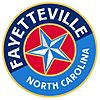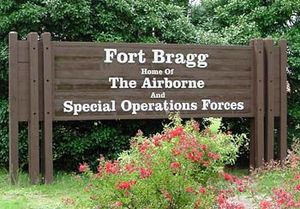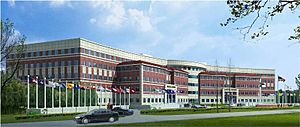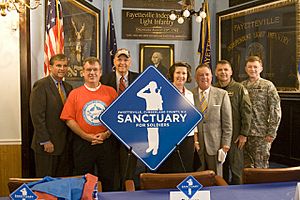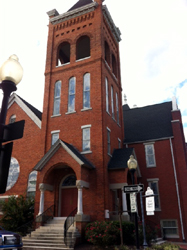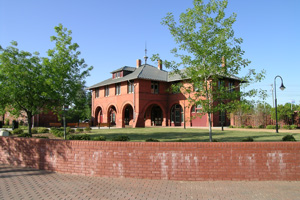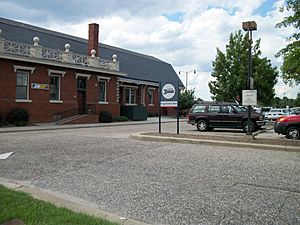Fayetteville, North Carolina facts for kids
Quick facts for kids
Fayetteville
|
|||||
|---|---|---|---|---|---|
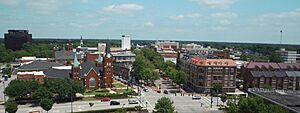
Downtown Fayetteville
|
|||||
|
|||||
| Nicknames:
America's Can Do City, All-American City, City of Dogwoods, Fayettenam, The Ville, 2-6, The Soldier City
|
|||||
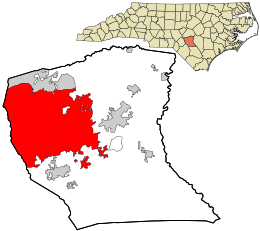
Location in Cumberland County and North Carolina
|
|||||
| Country | United States | ||||
| State | North Carolina | ||||
| County | Cumberland | ||||
| Settled | 1783 | ||||
| Named for | Gilbert du Motier, Marquis de Lafayette | ||||
| Government | |||||
| • Type | Council-Manager | ||||
| Area | |||||
| • Total | 150.08 sq mi (388.71 km2) | ||||
| • Land | 148.26 sq mi (383.99 km2) | ||||
| • Water | 1.82 sq mi (4.73 km2) 1.21% | ||||
| Elevation | 223 ft (68 m) | ||||
| Population
(2020)
|
|||||
| • Total | 208,501 | ||||
| • Estimate
(2023)
|
209,749 | ||||
| • Rank | 110th In the United States 6th in North Carolina |
||||
| • Density | 1,406.34/sq mi (542.99/km2) | ||||
| • Urban | 325,008 (US: 125th) | ||||
| • Urban density | 1,658.8/sq mi (640.5/km2) | ||||
| • Metro | 392,336 (US: 142nd) | ||||
| Time zone | UTC−5 (Eastern (EST)) | ||||
| • Summer (DST) | UTC−4 (EDT) | ||||
| ZIP code |
28301, 28302, 28303, 28304, 28305, 28306, 28307 (Fort Liberty), 28308 (Pope AAF), 28309, 28310 (Fort Liberty), 28311, 28312, 28314
|
||||
| Area codes | 910, 472 | ||||
| FIPS code | 37-22920 | ||||
| GNIS feature ID | 2403604 | ||||
| Primary Airport | Fayetteville Regional Airport | ||||
| Public transportation | Fayetteville Area System of Transit | ||||
Fayetteville is a city in North Carolina, United States. It's the main city in Cumberland County. Fayetteville is famous for being home to Fort Liberty, a big U.S. Army base.
The city has won the All-America City Award three times. In 2020, about 208,501 people lived here. This makes it the 6th largest city in North Carolina. Fayetteville is located in the Sandhills area, near the Cape Fear River.
The larger area around Fayetteville, including towns like Hope Mills and Spring Lake, has about 392,336 people. This makes it a major area in southeastern North Carolina.
Contents
- History of Fayetteville
- Fort Liberty and Pope Army Airfield
- Geography of Fayetteville
- People of Fayetteville
- Fayetteville's Economy
- Arts and Culture in Fayetteville
- Sports in Fayetteville
- Education in Fayetteville
- Media in Fayetteville
- Getting Around Fayetteville
- Famous People from Fayetteville
- Sister City
- See also
History of Fayetteville
How Fayetteville Started
Long ago, different Native American groups lived in the area where Fayetteville is now. They had lived there for over 12,000 years.
In the early 1700s, after some wars, English settlers moved to the Cape Fear River area. Two small towns, Cross Creek and Campbellton, were started by Scots.
Later, in 1783, Cross Creek and Campbellton joined together. The new town was named Fayetteville. It was named after Gilbert du Motier, Marquis de Lafayette, a French hero who helped America in the war. Fayetteville was the first city in the U.S. to be named after him! Lafayette even visited the city in 1825.
The American Revolution in Fayetteville
Many Scottish people lived in this area in the 1700s. Most of them stayed loyal to the British government during the American Revolution. However, there were also many people who supported the Revolution.
In 1775, before the Declaration of Independence, local people signed the "Liberty Point Resolves." This showed they wanted freedom from Britain.
One important person was Robert Rowan. He was a merchant and a leader for the American side. He helped organize the group that signed the Liberty Point Resolves.
Flora MacDonald, a famous Scottish woman, also lived here. She was loyal to the British King and helped her husband gather local Scots to fight for the King.
After the Revolution
Fayetteville had a great time in the 1780s. In 1789, the state meeting to approve the U.S. Constitution happened here. The University of North Carolina at Chapel Hill was also started during a meeting in Fayetteville. However, Fayetteville did not become the permanent state capital. That honor went to Raleigh.
In 1793, the Fayetteville Independent Light Infantry was formed. It's still active today as a ceremonial group. It's one of the oldest military groups in the country.
Henry Evans, a free black preacher, is known as the "Father of Methodism" in the area. He built the first church in town in 1796. It was called the African Meeting House.
The Great Fire and Civil War
In 1831, Fayetteville had a huge fire. It was one of the worst fires in U.S. history, but luckily, no one died. Many homes and buildings were destroyed.
The Market House, finished in 1832, became the new center of town. It was a market for many years and then the town hall.
During the American Civil War, in 1865, General William Tecumseh Sherman and his army attacked Fayetteville. They destroyed a Confederate weapons factory and other buildings. There was also a small fight between soldiers in downtown Fayetteville.
After the Civil War, new laws were made that separated people based on their race. This meant black people lost many rights. This continued for over sixty years until new laws were passed in the 1960s.
Fayetteville in the 20th Century and Today
After World War II, Fayetteville and Cumberland County grew very fast. Many new homes and shopping areas were built. Schools in the area slowly started to allow students of all races to learn together.
During the Vietnam War, many soldiers trained at Fort Bragg before going to war. This helped local businesses. There were also anti-war protests in Fayetteville, which got national attention.
Today, Fayetteville has been working to make its downtown area better. New places like the Airborne & Special Operations Museum and Festival Park have been built. Many large companies have also moved to the area.
In 2005, new military commands moved to Fort Bragg. This brought many more people and businesses to the area. In 2009, a magazine named Fayetteville one of the best places for military families to retire.
In 2015, Fayetteville unveiled the world's biggest Christmas stocking! It weighed about 1600 pounds and was huge.
Fort Liberty and Pope Army Airfield
Fort Liberty (formerly Fort Bragg) and Pope Army Airfield are important military bases in Fayetteville. Many U.S. Army airborne units are based at Fort Liberty, like the 82nd Airborne Division.
Fort Liberty was a key place for the Army's artillery units during World War II. Soldiers even tested the first "Jeep" here!
Pope Field helps transport American soldiers and supplies all over the world. It's especially important for moving the 82nd Airborne Division. Some fighter jet squadrons used to be at Pope Field, but they have moved. Now, the Air Force Reserves are the main group there.
In 2008, Fayetteville officially added most of Fort Liberty to its city limits. This made the city much larger and helped attract more businesses.
A Sanctuary for Military Families
In 2008, Cumberland County announced it was the "World's First Sanctuary for Soldiers and Their Families." This means the community works hard to support military families.
They offer services like free childcare and help finding jobs for military spouses. Many volunteers and local businesses offer discounts and special help to military families. Time magazine even called Fayetteville "America's Most Pro-Military Town."
Geography of Fayetteville
Fayetteville is located in the Sandhills area of North Carolina. This area is between the flat coastal plain and the hilly Piedmont region.
The city is built along the Cape Fear River. This river is about 202 miles (325 km) long and flows into the Atlantic Ocean. There's also a beautiful waterfall called Carver's Falls nearby.
Climate
Fayetteville has a humid subtropical climate. This means it has mostly mild temperatures all year. Winters are usually mild, but it can snow a few days each year. Summers are hot and humid, often with thunderstorms. The highest temperature ever recorded was 110°F (43°C) in 1983. In 2011, a strong tornado hit Fayetteville during a big tornado outbreak in North Carolina.
| Climate data for Fayetteville, North Carolina (1981–2010 normals) | |||||||||||||
|---|---|---|---|---|---|---|---|---|---|---|---|---|---|
| Month | Jan | Feb | Mar | Apr | May | Jun | Jul | Aug | Sep | Oct | Nov | Dec | Year |
| Record high °F (°C) | 81 (27) |
85 (29) |
97 (36) |
96 (36) |
102 (39) |
105 (41) |
107 (42) |
110 (43) |
106 (41) |
101 (38) |
88 (31) |
86 (30) |
110 (43) |
| Mean daily maximum °F (°C) | 52.7 (11.5) |
56.4 (13.6) |
64.4 (18.0) |
73.5 (23.1) |
80.5 (26.9) |
87.4 (30.8) |
90.3 (32.4) |
88.2 (31.2) |
82.8 (28.2) |
73.7 (23.2) |
65.3 (18.5) |
55.6 (13.1) |
72.6 (22.6) |
| Daily mean °F (°C) | 41.6 (5.3) |
44.6 (7.0) |
51.7 (10.9) |
60.3 (15.7) |
68.5 (20.3) |
76.7 (24.8) |
80.3 (26.8) |
78.6 (25.9) |
72.5 (22.5) |
61.9 (16.6) |
52.9 (11.6) |
44.3 (6.8) |
61.2 (16.2) |
| Mean daily minimum °F (°C) | 30.5 (−0.8) |
32.8 (0.4) |
39.0 (3.9) |
47.2 (8.4) |
56.6 (13.7) |
66.1 (18.9) |
70.4 (21.3) |
69.0 (20.6) |
62.2 (16.8) |
50.0 (10.0) |
40.5 (4.7) |
33.0 (0.6) |
49.8 (9.9) |
| Record low °F (°C) | −2 (−19) |
−5 (−21) |
14 (−10) |
20 (−7) |
32 (0) |
40 (4) |
51 (11) |
46 (8) |
28 (−2) |
21 (−6) |
15 (−9) |
2 (−17) |
−5 (−21) |
| Average precipitation inches (mm) | 3.64 (92) |
3.16 (80) |
3.83 (97) |
3.06 (78) |
3.32 (84) |
4.42 (112) |
5.37 (136) |
5.56 (141) |
4.13 (105) |
3.03 (77) |
2.94 (75) |
2.96 (75) |
45.42 (1,154) |
| Average snowfall inches (cm) | 0.4 (1.0) |
0.2 (0.51) |
0.2 (0.51) |
0.0 (0.0) |
0.0 (0.0) |
0.0 (0.0) |
0.0 (0.0) |
0.0 (0.0) |
0.0 (0.0) |
0.0 (0.0) |
0.0 (0.0) |
0.2 (0.51) |
1.0 (2.5) |
| Average precipitation days (≥ 0.01 in) | 10.8 | 9.2 | 9.5 | 8.0 | 8.9 | 9.8 | 11.6 | 10.8 | 8.2 | 7.4 | 7.3 | 9.8 | 111.3 |
| Average snowy days (≥ 0.1 in) | 0.1 | 0.1 | 0 | 0 | 0 | 0 | 0 | 0 | 0 | 0 | 0 | 0.1 | 0.3 |
| Source: NOAA | |||||||||||||
People of Fayetteville
| Historical population | |||
|---|---|---|---|
| Census | Pop. | %± | |
| 1790 | 1,536 | — | |
| 1820 | 3,532 | — | |
| 1830 | 2,868 | −18.8% | |
| 1840 | 4,285 | 49.4% | |
| 1850 | 4,646 | 8.4% | |
| 1860 | 4,790 | 3.1% | |
| 1870 | 4,660 | −2.7% | |
| 1880 | 3,485 | −25.2% | |
| 1890 | 4,222 | 21.1% | |
| 1900 | 4,670 | 10.6% | |
| 1910 | 7,045 | 50.9% | |
| 1920 | 8,877 | 26.0% | |
| 1930 | 13,049 | 47.0% | |
| 1940 | 17,428 | 33.6% | |
| 1950 | 34,715 | 99.2% | |
| 1960 | 47,106 | 35.7% | |
| 1970 | 53,510 | 13.6% | |
| 1980 | 59,507 | 11.2% | |
| 1990 | 112,948 | 89.8% | |
| 2000 | 121,015 | 7.1% | |
| 2010 | 200,782 | 65.9% | |
| 2020 | 208,501 | 3.8% | |
| 2023 (est.) | 209,749 | 4.5% | |
| U.S. Decennial Census 2010 2020 |
|||
Population Details
In 2020, Fayetteville had 208,501 people. There were 82,087 households and 46,624 families living in the city.
| Race | Number | Percentage |
|---|---|---|
| Black or African American (non-Hispanic) | 87,193 | 41.82% |
| White (non-Hispanic) | 71,917 | 34.49% |
| Native American | 1,993 | 0.96% |
| Asian | 6,487 | 3.11% |
| Pacific Islander | 980 | 0.47% |
| Other/Mixed | 13,662 | 6.55% |
| Hispanic or Latino | 26,269 | 12.6% |
In 2010, the city had about 200,564 people. About 25.8% of the people were under 18 years old. The average age was 29.9 years.
Places of Worship
Fayetteville has many different churches and places of worship. Old Bluff Presbyterian Church, founded in 1758, is one of the oldest churches in the area.
There are many Catholic, Baptist, Pentecostal, Methodist, and Presbyterian churches. Fayetteville is also home to Congregation Beth Israel, a Jewish community started in 1910.
St. Patrick Church is the oldest Catholic church in North Carolina. The Masjid Omar ibn Sayyid mosque is named after Omar ibn Said, an African Muslim who lived in Fayetteville in the 1800s.
Fayetteville's Economy
Fort Liberty is the most important part of Fayetteville's economy. The military bases bring in about $4.5 billion each year. This makes Fayetteville a great place for shops, restaurants, and other businesses.
In March 2019, the unemployment rate in Fayetteville was 5.2%. This was a bit higher than the national average at the time.
Major Employers
Here are some of the biggest employers in Fayetteville:
| # | Employer | # of Employees |
|---|---|---|
| 1 | Department of Defense (Civilian) (Fort Liberty) | 14,036 |
| 2 | Cape Fear Valley Health System | 7,000 |
| 3 | Cumberland County Public School System | 6,042 |
| 4 | Wal-Mart | 3,956 |
| 5 | Goodyear Tire and Rubber Company | 2,500 |
| 6 | Cumberland County Government | 2,095 |
| 7 | Veterans Administration | 2,000 |
| 8 | City of Fayetteville | 1,776 |
| 9 | Fayetteville Technical Community College | 1,383 |
| 10 | Fayetteville State University | 885 |
Defense Industry
Fayetteville has a big and growing defense industry. Many top defense companies, like Lockheed Martin and Boeing, have offices here. The city also has a group called Partnership for Defense Initiatives (PDI) that helps defense companies.
Arts and Culture in Fayetteville
Arts and culture are important in Fayetteville. In 2022, local arts groups brought in $72.2 million for the economy. They also supported over 1,100 jobs. In 2024, it was announced that arts and cultural events brought over 900,000 visitors to the area.
Fun Things to Do
Festivals
- Fayetteville Dogwood Festival
- International Folk Festival
- Juneteenth celebrations
- 4th Fridays (monthly downtown events)
Historic Places
- Cool Spring Tavern (the oldest building in Fayetteville)
- Evans Metropolitan AME Zion Church
- Heritage Square
Museums
- Airborne & Special Operations Museum (learn about soldiers)
- Fascinate-U Children's Museum (hands-on fun for kids)
- Museum of the Cape Fear Historical Complex (local history)
Parks and Outdoor Fun
- Cape Fear Botanical Garden (beautiful plants and nature)
- Freedom Memorial Park (honors veterans)
- Mazarick Park
Shopping
Theaters and Arenas
- Crown Coliseum (for big events and sports)
- Cape Fear Regional Theatre (live plays)
Sports in Fayetteville
Fayetteville has a few sports teams:
| Club | Sport | League | Venue | Established | Championships |
|---|---|---|---|---|---|
| Fayetteville Woodpeckers | Baseball | Carolina League | Segra Stadium | 2017 | 1 |
| Fayetteville Marksmen | Ice hockey | SPHL | Crown Coliseum | 2002 | 1 |
Education in Fayetteville
Public Schools
Cumberland County Schools is the main school system in Fayetteville. It runs 87 schools, including elementary, middle, and high schools. It's the fourth-largest school system in North Carolina.
Students living on Fort Liberty go to special schools there for younger grades. For high school, they attend local public schools.
High Schools (Grades 9–12)
- Cape Fear High School
- Douglas Byrd High School
- Ezekiel Ezra "E.E." Smith High School
- Jack Britt High School
- Pine Forest High School
- Seventy-First High School
- Terry Sanford High School
- Westover High School
- South View High School
- Gray's Creek High School
Specialty High Schools
- Cross Creek Early College High School
- Cumberland International Early College High School
- Massey Hill Classical High School
- Cumberland Polytechnic High School
Private Schools
- Berean Baptist Academy
- Fayetteville Academy
- Fayetteville Christian School
- Northwood Temple Academy
- Village Christian Academy
- Trinity Christian School
Colleges and Universities
- Carolina College of Biblical Studies
- Manna University
- Fayetteville State University
- Fayetteville Technical Community College
- Methodist University
- Shaw University Satellite Campus
Media in Fayetteville
Newspapers
- The Fayetteville Observer
- Up & Coming Weekly
- The Voice
- The Fayetteville Press
- Acento Latino
- The Paraglide
Television and Radio
Fayetteville gets its TV channels from the Raleigh–Durham area. There is also FayTV7, which is the city's government channel.
Many radio stations serve Fayetteville, playing different types of music and talk shows.
Getting Around Fayetteville
Major Roads
Fayetteville is connected by important highways like I-95. This highway runs along the East Coast of the U.S. Other major roads include US 13, US 301, and US 401.
Air Travel
Fayetteville Regional Airport has flights to other major airports. This makes it easy to travel to and from Fayetteville.
Public Transportation
The Fayetteville Area System of Transit (FAST) provides bus services around Fayetteville and Spring Lake. The buses run on weekdays and Saturdays.
Train Travel
The historic Atlantic Coast Line Railroad Station offers daily Amtrak train service. You can take a train north or south along the East Coast from Fayetteville.
Famous People from Fayetteville
Sister City
Fayetteville has one sister city:
 Saint-Avold, France
Saint-Avold, France
See also
 In Spanish: Fayetteville (Carolina del Norte) para niños
In Spanish: Fayetteville (Carolina del Norte) para niños



